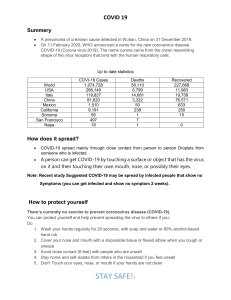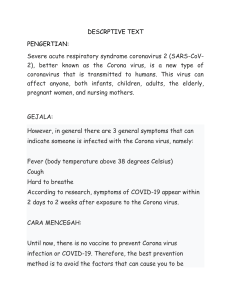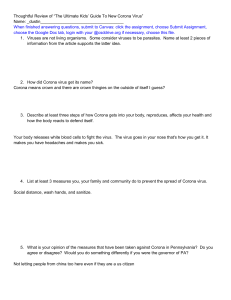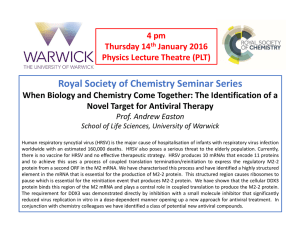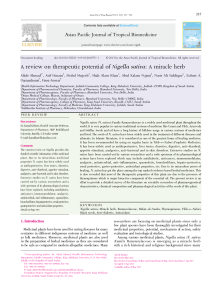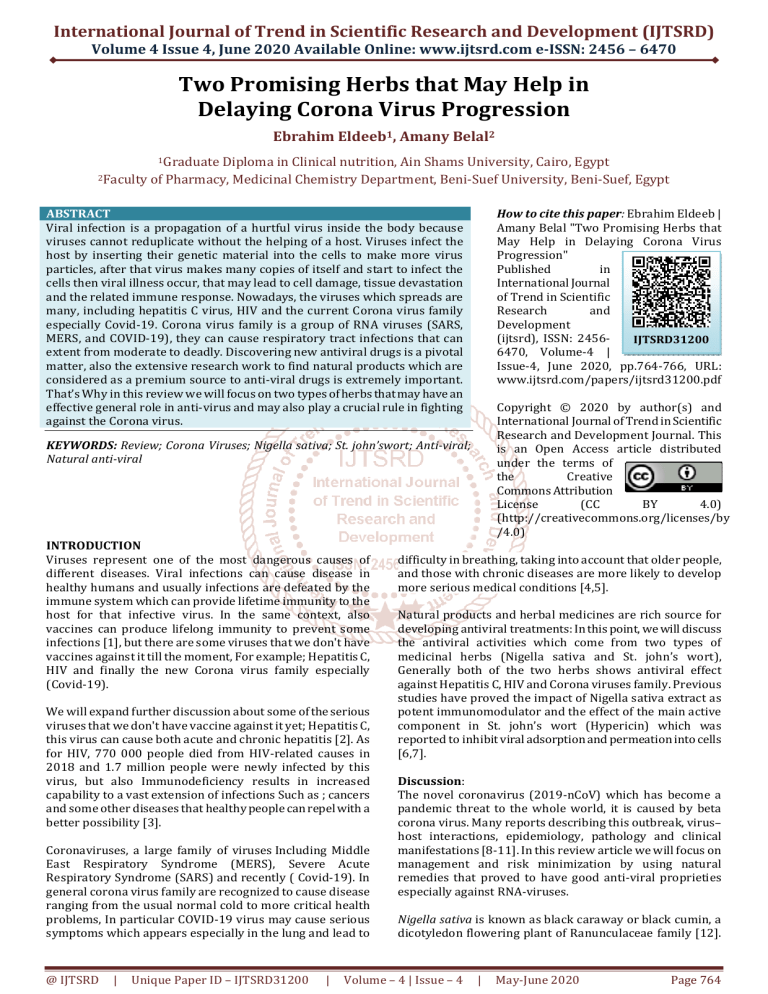
International Journal of Trend in Scientific Research and Development (IJTSRD) Volume 4 Issue 4, June 2020 Available Online: www.ijtsrd.com e-ISSN: 2456 – 6470 Two Promising Herbs that May Help in Delaying Corona Virus Progression Ebrahim Eldeeb1, Amany Belal2 1Graduate 2Faculty Diploma in Clinical nutrition, Ain Shams University, Cairo, Egypt of Pharmacy, Medicinal Chemistry Department, Beni-Suef University, Beni-Suef, Egypt ABSTRACT Viral infection is a propagation of a hurtful virus inside the body because viruses cannot reduplicate without the helping of a host. Viruses infect the host by inserting their genetic material into the cells to make more virus particles, after that virus makes many copies of itself and start to infect the cells then viral illness occur, that may lead to cell damage, tissue devastation and the related immune response. Nowadays, the viruses which spreads are many, including hepatitis C virus, HIV and the current Corona virus family especially Covid-19. Corona virus family is a group of RNA viruses (SARS, MERS, and COVID-19), they can cause respiratory tract infections that can extent from moderate to deadly. Discovering new antiviral drugs is a pivotal matter, also the extensive research work to find natural products which are considered as a premium source to anti-viral drugs is extremely important. That’s Why in this review we will focus on two types of herbs that may have an effective general role in anti-virus and may also play a crucial rule in fighting against the Corona virus. How to cite this paper: Ebrahim Eldeeb | Amany Belal "Two Promising Herbs that May Help in Delaying Corona Virus Progression" Published in International Journal of Trend in Scientific Research and Development (ijtsrd), ISSN: 2456IJTSRD31200 6470, Volume-4 | Issue-4, June 2020, pp.764-766, URL: www.ijtsrd.com/papers/ijtsrd31200.pdf Copyright © 2020 by author(s) and International Journal of Trend in Scientific Research and Development Journal. This is an Open Access article distributed under the terms of the Creative Commons Attribution License (CC BY 4.0) (http://creativecommons.org/licenses/by /4.0) KEYWORDS: Review; Corona Viruses; Nigella sativa; St. john’swort; Anti-viral; Natural anti-viral INTRODUCTION Viruses represent one of the most dangerous causes of different diseases. Viral infections can cause disease in healthy humans and usually infections are defeated by the immune system which can provide lifetime immunity to the host for that infective virus. In the same context, also vaccines can produce lifelong immunity to prevent some infections [1], but there are some viruses that we don't have vaccines against it till the moment, For example; Hepatitis C, HIV and finally the new Corona virus family especially (Covid-19). We will expand further discussion about some of the serious viruses that we don't have vaccine against it yet; Hepatitis C, this virus can cause both acute and chronic hepatitis [2]. As for HIV, 770 000 people died from HIV-related causes in 2018 and 1.7 million people were newly infected by this virus, but also Immunodeficiency results in increased capability to a vast extension of infections Such as ; cancers and some other diseases that healthy people can repel with a better possibility [3]. Coronaviruses, a large family of viruses Including Middle East Respiratory Syndrome (MERS), Severe Acute Respiratory Syndrome (SARS) and recently ( Covid-19). In general corona virus family are recognized to cause disease ranging from the usual normal cold to more critical health problems, In particular COVID-19 virus may cause serious symptoms which appears especially in the lung and lead to @ IJTSRD | Unique Paper ID – IJTSRD31200 | difficulty in breathing, taking into account that older people, and those with chronic diseases are more likely to develop more serious medical conditions [4,5]. Natural products and herbal medicines are rich source for developing antiviral treatments: In this point, we will discuss the antiviral activities which come from two types of medicinal herbs (Nigella sativa and St. john’s wort), Generally both of the two herbs shows antiviral effect against Hepatitis C, HIV and Corona viruses family. Previous studies have proved the impact of Nigella sativa extract as potent immunomodulator and the effect of the main active component in St. john’s wort (Hypericin) which was reported to inhibit viral adsorption and permeation into cells [6,7]. Discussion: The novel coronavirus (2019-nCoV) which has become a pandemic threat to the whole world, it is caused by beta corona virus. Many reports describing this outbreak, virus– host interactions, epidemiology, pathology and clinical manifestations [8-11]. In this review article we will focus on management and risk minimization by using natural remedies that proved to have good anti-viral proprieties especially against RNA-viruses. Nigella sativa is known as black caraway or black cumin, a dicotyledon flowering plant of Ranunculaceae family [12]. Volume – 4 | Issue – 4 | May-June 2020 Page 764 International Journal of Trend in Scientific Research and Development (IJTSRD) @ www.ijtsrd.com eISSN: 2456-6470 Food and Drug Administration In the United States of America classifies Nigella sativa as Generally Recognized as Safe (GRAS) and can be used as a spice or natural flavoring agent [13]. Seeds of N. sativa are traditionally used as a spice also in Middle Eastern cuisines, Palestine, India, Bengali and Polish cuisine that prove safety of these valuable seeds. In addition the black seed have been reported to have various number of significant medicinal effects against many health disorders [14]. e.g. Anticancer, antioxidant, antimicrobial, anthelminthic and antiviral [15-17, 6]. Moreovere, it has been reported that Ns has showed antiviral activity against ILT Virus [18]. Ns have various pharmacological activities as it has many active constituents e.g. volatile oils, alkaloids and proteins [19]. it was also found that Ns can act as immunomodulator as it can increase T4 (helper T cell), T8 (suppressor T cells) and NK (natural killer cells) [20]. In addition Nigella sativa extract proved to have inhibitory effect on HIV protease [21]. Upon treatment of hepatitis C patients with NS, it was observed that the liver enzymes AST (Aspartate aminotransaminase) and ALT (Alanine aminotransferase) became in the normal range, in addition decrease in the viral load was also observed [22]. Moreover, black seed powder mixed with honey to form 10 ml paste was administered to pregnant women with positive HIV at the third trimester three times daily for one year, the obtained results revealed no transmission of HIV infection to any of the new born babies [23]. Corona virus family can cause many health problems as respiratory diseases with high mortality rate, bronchitis, hepatitis in both humans and animals, In 2003, SARS-CoV appeared, in 2012 MERS-CoV also appeared and killed many peoples, recently covid-19 that caused death of around 320000 around the world till now, so that corona virus family is a dangerous killer and continuous research should be conducted to protect human from them. HeLa-CEACAM1a cells were treated with Ns extract prior to viral infection with cov and the obtained results revealed replication decrease of cov [24]. These observations support the promiscuity of Ns extract to fight against RNA viruses eg. HCV, HIV and Cov. Ns. Contains alkaloids with the isoquinoline backbone as nigellicimine and nigellicimine-N-oxide [25], isoquinoline is a bioisostere of quinoline which is the backbone of hydroxychloroquine, however the previous research reports focus on Ns whole extract and further studies need to be conducted to know the specific constituent which is responsible for giving Ns extract their antiviral properties. The second point of our interest in this review article is the natural phytochemical which is hypericin, it is anthraquinone derivative and is considered one of the active constituents of Hypericum (Saint John's wort), it has diverse pharmacological activities e.g. antibacterial, antiviral and antidepressant. It can inhibit dopamine βhydroxylaseenzyme, then dopamine levels will be increased resulting in antidepressant effect [26-28]. Hypericin revealed good activity against HCV, as it can downregulate and deacetylate heme oxygenase 1 enzyme so that the replication of HCV is decreased in hepatoma cells [29]. @ IJTSRD | Unique Paper ID – IJTSRD31200 | Additionally the ability of hypericin to inhibit HIV-1 replication was evaluated and it showed to inhibit HIV-1 in a dose dependent manner, However, its light-dependent antiviral activity is still representing a challenge in applicability of hyperictin against HIV [30]. Extract of H. Perforatumwith, its main active component Hypericin, was tested under light protected conditions and proved to have potent properties as anti IBV (Which is one of Coronaviruses family), this observed effect due to the reduced levels of mRNA expression of IL-6, TNF-α and upregulated levels of mRNA expression of type I interferon. This prove the usefulness of H. perforatum extract for getting new promising antiviral agents[31]. However, we still need further studies to investigate the mechanism of action. Conclusion In this review article we tried to find herbal medicinal products that may help in minimizing the risk of coronavirus (Covid-19) as there is growing global interest with herbal medications. Activity of Nigella sativa and St. john’s wort against many types of viruses especially corona virus family give us the hope and also support the postulation that these two herbs may help in delaying the progression of covid-19 infection. These valuable facts deserve consideration and further studies to let these herbal medications turned into practice. References [1] How Vaccines Work. (2019, September 18). Retrieved from https://vaccineinformation.org/how-vaccineswork [2] Hepatitis C. (2019, July 9). Retrieved https://www.who.int/news-room/factsheets/detail/hepatitis-c from [3] HIV/AIDS. (2019, November 15). Retrieved from https://www.who.int/news-room/factsheets/detail/hiv-aids [4] Coronavirus. (2019, May 19). Retrieved from https://www.who.int/health-topics/coronavirus [5] COVID-19. (2019, May 20). Retrieved from http://www.emro.who.int/health-topics/coronavirus/questions-and-answers.html [6] Shamim Molla, Md. Abul Kalam Azad, Md Ali Azam Al Hasib, M. Monayem Hossain, Md. Sohel Ahammed, Shohel Rana, Muhammad Torequl Islam. A REVIEW ON ANTIVIRAL EFFECTS OF NIGELLA SATIVA L. 2019; 2 : 47-53 . [7] N. D. Weber, B. K. Murray, J. A. North and S. G. Wood. The antiviral agent hypericin has in vitro activity against HSV-1 through non-specific association with viral and cellular membranes. Antiviral Chemistry & Chemotherapy (1994) 5(2), 83-90 . [8] Ahmet Riza Sahin, Aysegul Erdogan, Pelin Mutlu Agaoglu, Yeliz Dineri,Ahmet Yusuf Cakirci,Mahmut Egemen Senel,Ramazan Azim Okyay, Ali Muhittin Tasdogan. 2019 Novel Coronavirus (COVID-19) Outbreak: A Review of the Current Literature. EJMO 2020; 4(1):1–7 . Volume – 4 | Issue – 4 | May-June 2020 Page 765 International Journal of Trend in Scientific Research and Development (IJTSRD) @ www.ijtsrd.com eISSN: 2456-6470 [9] Yvonne Xinyi Lim, Yan Ling Ng, James P. Tam and Ding Xiang Liu. Human Coronaviruses: A Review of Virus– Host Interactions. Diseases 2016 Sep; 4(3): 26. [10] Francesco Di Gennaro, Damiano Pizzol, Claudia Marotta, Mario Antunes, Vincenzo Racalbuto ,Nicola Veronese and Lee Smith. Coronavirus Diseases (COVID19) Current Status and Future Perspectives: A Narrative Review. Int J Environ Res Public Health. 2020 Apr 14; 17(8):E2690. [11] Mingxuan Xie, Qiong Chen. Insight into 2019 novel coronavirus — An updated interim review and lessons from SARS-CoV and MERS-CoV. Int J Infect Dis. 2020 May; 94:119-124. [12] Andreas G. Heiss · Klaus Oeggl. The oldest evidence of Nigella damascena L. (Ranunculaceae) and its possible introduction to central Europe.VegetHistArchaeobot (2005) 14:562–570. [13] "Substances generally recognized as safe: Sec. 182.10. Spices and other natural seasonings and flavorings". US Food and Drug Administration, Code of Federal Regulations, 21CFR182.10. 2019-04-01. Retrieved 2020-05-17. [14] Islam MT, Khan MR, Mishra SK (2018) An updated literature-based review: Phytochemistry, pharmacology and therapeutic promises of Nigella sativa L. Oriential Pharmacy and Experimental Medicine. Doi: 10.1007/s13596-019-00363-3. [15] Hanafy M, Hatem M (1991) Studies on the antimicrobial activity of Nigella sativa seed (black cumin). J Ethnopharmacol 34:275-8. [16] Akhtar M, Riffat S (1991) Field trial of Saussurealappa roots against nematodes and Nigella sativa seeds against ces- todes in children. J Pakistan Med Assoc 41:185-7. [17] Nagi M, Alam K, Badary O, Al-Shabanah O, Al- SawafH, Al-Bekairi A (1999) Thymoquinone protects against carbontetrachloride hepatotoxicity in mice via an antioxidantmechanism. BiochemMolBiolInt 47:153-9. [18] Kawther S. Zaher, W.M. Ahmed and Sakina N. Zerizer. Observations on the Biological Effects of Black Cumin Seed (Nigella sativa) and Green Tea (Camellia sinensis).Global Veterinaria 2 (4): 198-204, 2008. [19] Zafar K, Noorul H, Nesar A, Vartika S, Khalid M, Prashant S, Zeeshan A, Zohrameena S. Pharmacological Activity of Nigella Sativa: A ReviewWorld J Pharm Sci 2016; 4(5): 234-241. [20] El-Kadi A, Kandil O. Effect of Nigella sativa (the black seed) on immunity. In: Proceedings of the Fourth International Conference onIslamic Medicine, 4 November, Kuwait, pp. 1986; 344–348. @ IJTSRD | Unique Paper ID – IJTSRD31200 | [21] Ma CM, Miyashiro H, Hattori M, Shimotohno K. Screening of traditional medicines for their inhibitory effects on human immunodeficiency virus protease. J. Tradit. Med. 1994; 11 (4), 416–417. [22] Barakat, E. M., El Wakeel, L. M., and Hagag, R. S. (2013).Effects of Nigella sativa on outcome of hepatitis C in Egypt. World Journal of Gastroenterology, Volume (19), Pages 2529-2536. [23] Onifade, A. A., Jewell, A. P., and Okesina, A. B.SERONEGATIVE CONVERSION OF AN HIV POSITIVE SUBJECT TREATED WITH NIGELLA SATIVA AND HONEY. Afr. J. Infect. Dis. (2015) 9(2): 47 – 50. [24] Mustafa Ulasli • Serdar A. Gurses • RecepBayraktar • OnderYumrutas •SerdarOztuzcu • MehriIgci • Yusuf ZiyaIgci • Ecir Ali Cakmak •AhmetArslan. The effects of Nigella sativa (Ns), Anthemishyalina (Ah) and Citrus sinensis (Cs) extracts on the replication of coronavirus and the expression of TRP genes family. MolBiol Rep (2014) 41:1703–1711. [25] M. Akram Kha1• M. Afzal. Chemical composition of Nigella sativa Linn: Part 2 Recent Advances. Inflammopharmacol (2016) 24:67–79 DOI 10.1007/s10787-016-0262-7. [26] Oubre, Alondra (1991). "Hypericin: the active ingredient in Saint John's Wort". Archived from the original on September 28, 2007.Retrieved September 18, 2006. [27] I.LOPEZ-BAZZOCCJHI j. B. HUDSON and G. H. N. TOWERS.ANTIVIRAL ACTIVITY OF THE PHOTOACTIVE PLANT PIGMENT HYPERICIN.Photochemistry and Photoblology Vol. 54, No. I, pp. 95-98, 1991. [28] J. B. Hudson, I. Lopez-BazzocchF and G.H.N. Towers. Antiviral activities of hypericin. Antiviral Research, 15 (1991) 101-112. [29] Chao-Ming Shih, Chih-Hsien Wu, Wen-Jun Wu, Yi-Min Hsiao, Jiunn-Liang Ko. Hypericin inhibits hepatitis C virus replication via deacetylation and downregulation of heme oxygenase-1. Phytomedicine Volume 46, 15 July 2018, Pages 193-198. [30] Diane F Birt, Mark P Widrlechner, Kimberly DP Hammer, Matthew L Hillwig, Jingqiang Wei, George A Kraus, Patricia A Murphy, JoeAnn McCoy, Eve S Wurtele, Jeffrey D Neighbors, David F Wiemer, Wendy J Maury and Jason P Price. Hypericumin infection: Identification of anti-viral and anti-inflammatory Constituents. Pharm Biol. 2009; 47(8): 774–782. [31] Huijie Chen, Ishfaq Muhammad, Yue Zhang, Yudong Ren, Ruili Zhang, Xiaodan Huang, Lei Diao, Haixin Liu, Xunliang Li, Xiaoqi Sun, Ghulam Abbas, Guangxing Li. Antiviral Activity Against Infectious Bronchitis Virus and Bioactive Components of Hypericum perforatum L. Front Pharmacol. 2019 Oct 29; 10:1272. Volume – 4 | Issue – 4 | May-June 2020 Page 766
